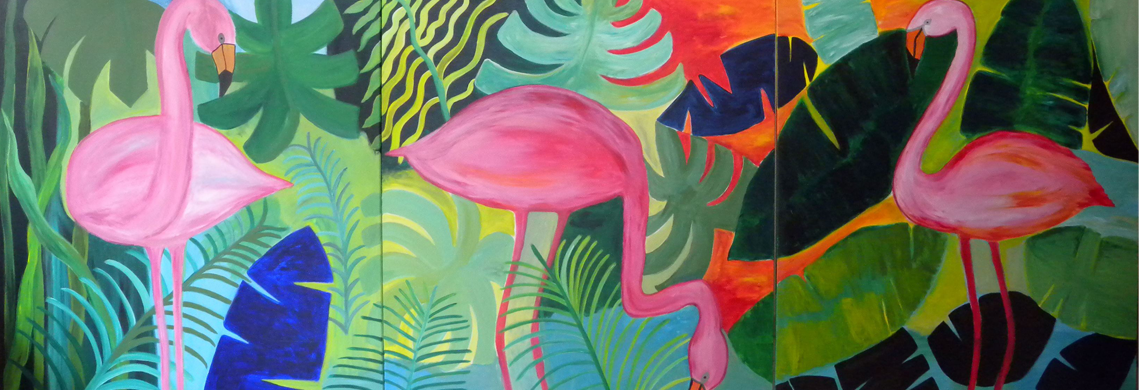Tropical flamingos by Virginia di Saverio
In fact, this image has been generously granted by Virginia di Saverio, an emerging painter who has published a book of poems (“Le stanze svelate” Giulio Perrone Editore). Virginia is passionate and intrigued by all the arts in general. She loves them and combines them with great passion. Painting, writing and even dance. Yes, in fact, when I met her, glancing through her pictures, I saw one showing her performing a belly dance, which she is very fond of, for its power to awaken the feminine side, its contact with the earth, and self-confidence. For me, getting to know Virginia was a pleasure. For those wishing to discover her world, here is her Instagram page: https://www.instagram.com/virginia_di_saverio/
But let’s go back to the flamingos, represented in this work, which strikes us for the celebration of colours and spontaneity, like many other works by this artist. This animal has recently regained fame. Big companies have used its image in advertising and commercial campaigns.
Printed on t-shirts and bags, waved like a flag, the flamingo has invaded shop windows and shelves. Its charm and its mythological symbolism relate it to rebirth, sensitivity, elegance and positivity. All values, for which it also fascinates us.
According to SEO BirdLife, an organization that LiT knows and likes, regardless of its new found trendiness, the flamingo, like many other aquatic species, is suffering as a result of the loss of its habitat, drought and climate change.
In fact, according to the IUCN red list, many species of the Phoenicopteridae (Flamingo) family, including the Andean and the minor are listed as vulnerable or almost threatened.
Click here to read the full IUCN report on this species.
Personally, I have always connected the flamingo with the Caribbean or the Galapagos Islands. However, relatively stable colonies exist in Italy and Spain too.
An important colony in Spain exists in Fuente de Piedra (Málaga). Other minor settlement colonies are on the Ebro Delta, the Doñana and Odiel marshes.
In Italy pink flamingos are found mostly in Sardinia, but also in Sicily, Puglia and Emilia Romagna.
Flamingos are particularly vulnerable during the reproduction period, which normally extends from April to June.
I have read that this bird hatches with its legs folded under the body, and remains so for about thirty days. Then the chicks are born with short legs and a small beak; the chicks remain in the nest for almost four days despite being practically independent.
Two weeks after birth, the chicks are already able to feed themselves, following the example of adult flamingos, thus plunging their beaks and their heads into the water.
When we talk about this species in Spain and in Italy we refer to the common flamingo (Phoenicopterus roseus). But there are 5 other species in the world.
If any reader has more information, or would like to share knowledge or other studies on this beautiful animal, we will be happy to share them on the Blog.
I visited Doñana National Park a few years ago and it was really an incredible experience.
More recently, with my daughters, I have instead discovered the characteristic wetlands of the Ebro Delta, but I enjoyed the show without being able to take any decent photographs … for, as usual, my camera had no battery … and because I am a disaster with photos and images, I also wish to call for collaboration of artists and photographers who could be interested, like Virginia, to share their art to illustrate our posts.
Thank you all and see you next week.
Clicca qui per leggere questo post in italiano
Haz click aquí para leer esta entrada en español

